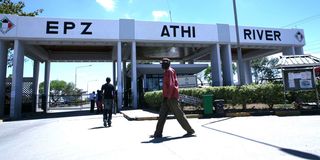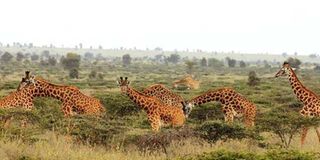
Entrance of the Export Processing Zone in Athi River, Machakos County.
The government plans to demolish some factories in the Export Processing Zone Authority (EPZA) in Machakos County to pave way for Nairobi National Park -Athi Kapiti Wildlife migration corridor.
The ambitious and costly project is meant to boost wildlife conservation and reduce human-wildlife conflicts rampant within the Athi Kapiti Wildlife circuit.

State Department for Wildlife Principal Secretary Silvia Museiya.
State Department for Wildlife Principal Secretary Silvia Museiya said the 100-meter-wide corridor has already been mapped running from the southeast of the National Park via the controversial state-owned sheep and goat land to EPZ. Then, the corridor extends through a part of East Africa Portland (EAPC) to Kapiti plains that straddle further east.
Kapiti Plains is a semi-arid rangeland in southeastern Nairobi National Park. It's a 13,000-hectare area owned by the International Livestock Research Institute (ILRI)
The plains are part of the wider Athi-Kapiti ecosystem, which is a crucial wildlife dispersal area for Nairobi National Park. An underground tunnel has been proposed across the Namanga highway.
"Factories along the corridor will be demolished and relocated. Within the zone. We have also engaged private landowners along the proposed corridor. We are currently registering private conservancies to accommodate them, “ the PS told Nation.

Giraffes browse at the Nairobi National Park in this Photo taken on June 17, 2015.
She added: “We have come up with a budget for the 2025/26 financial year (without revealing the amount). Though we are not focused on any compensation, we need resources for relocating some plant machinery and structures in EPZ."
She said the migration corridor project has President Ruto's nod and is awaiting cabinet approval.
"The Nairobi Park has been surrounded by human settlement, infrastructure and development. In the near future, we project a Nairobi national zoo, considering the park only covers 17,600 acres,“ said PS Museiya. “The mother ministry is optimistic in future the corridor will be opened to connect to Amboseli ecosystem,"
The PS spoke at Empakasi village, Athi River sub county on Saturday when overseeing issuance of compensation cheques to indigenous land owners under land lease programme by non-state wildlife foundation.
PS Museiya said the department is aware of rampant wildlife attacks attributed to animals straying from national parks and reserves due to several factors, including ecological, environmental, development and human settlements.
She said apart from a raft of mitigation measures the government is moving in earnest to settle wildlife attack victims compensation pending bills backdated to 2018.
The Wildlife Act of 2013 introduced new rates for compensation, including Sh5 million for death and Sh3 million for injury from animal attack.
" Kenya Kwanza inherited Sh15 billion pending bills. In the last two financial years, we have settled Sh1.936 billion. In this financial year, we are disbursing Sh1.76 billion," she added.
Read: Meru County workers celebrate return of office tea and snacks
She added the Ministry of Tourism and Wildlife has proposed a review of wildlife conservation to avert the high rate of conservation land into agriculture or commercial lands, owing to meagre conservation incentives.
"We are going on a serious deep dive to look at how conservation can pay. We are focusing on regulatory mechanisms for the sector, the wildlife economy after realising that as long as there are no benefits on revenue streams, conservation incentives are low, prompting more conversion of conservation land to settlement, agriculture and commercial purposes,“ said PS Museiya.
The Athi-Kapiti ecosystem pays homage to a diverse range of wild animals, including zebras, giraffes, elands, and wildebeests. Predators such as lions, leopards, cheetahs, and hyenas also call this area home. In addition to these, the plains are known for species like impala, warthog, and various gazelle species.







